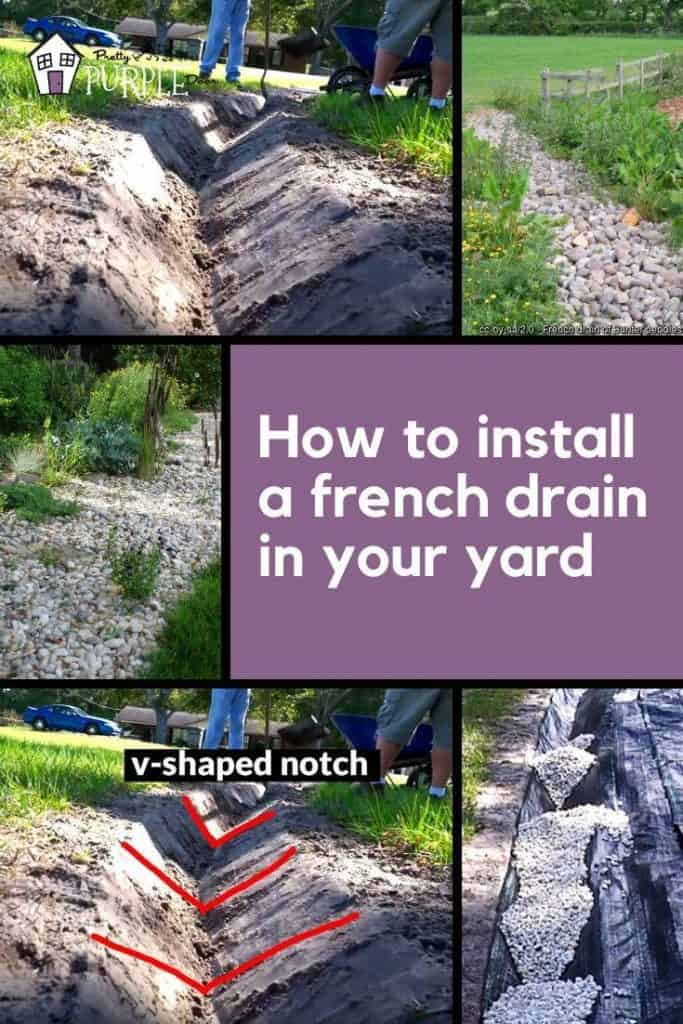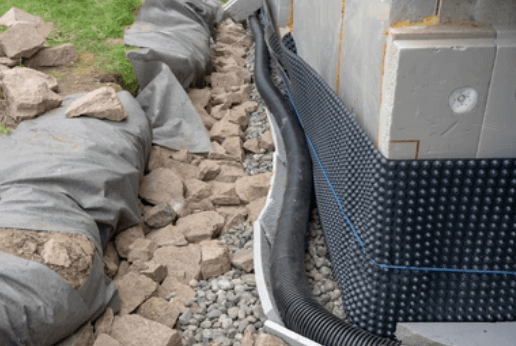How a Portland French Drain Stops Lower Level Flooding
The Important Guide to Preserving Your French Drain for Lasting Performance
Maintaining your French drain is essential to its efficiency and your building's defense. Normal checks can conserve you from expensive repair services and water damages. You'll would like to know what indications to search for and how typically to examine your system. Plus, understanding the cleaning procedure can make a substantial distinction. Let's explore the important steps for guaranteeing your drainpipe operates well for many years to find.
Understanding the Function of a French Drainpipe
A French drainpipe is a vital element in managing water around your home. It routes excess water far from your foundation, preventing flooding and damages. When hefty rain drops, the drainpipe gathers water through a perforated pipeline buried in gravel. This system allows water to stream freely, reducing pressure on your cellar wall surfaces and minimizing the danger of leaks.You might ask yourself how it operates in technique. As water fills the soil, gravity pulls it towards the drainpipe. The perforated pipeline catches this water, carrying it to a designated drainage location or tornado sewer. This procedure keeps your backyard dry and secures your home's structural integrity.Understanding exactly how a French drainpipe features is crucial to valuing its relevance. By effectively directing water away, it helps maintain a safe and dry living setting. So, maintaining your French drainpipe in leading problem guarantees you prevent pricey fixings down the line.
Regular Evaluations: What to Search for
Begin by checking for any blockages that might be obstructing water flow when you're inspecting your French drainpipe. Take notice of indicators of surface erosion around the drain, as this can show prospective issues. Routine evaluations will certainly aid keep your water drainage system functioning efficiently.
Clogged Drainpipe Analysis
Exactly how can you tell if your French drainpipe is clogged? Watch for water pooling in your yard, particularly after hefty rain. That's a red flag if you discover areas where water accumulates instead of draining. You ought to also check the drain outlet; if water isn't draining as it should, there's most likely an obstruction. Listen for uncommon gurgling sounds, which can indicate trapped air. Furthermore, inspect the drain's surface for any kind of plant life growth, as roots can penetrate and clog the system. Ultimately, if you scent stuffy smells, it could indicate stationary water triggered by a clog. Routinely evaluating these indicators can assist you preserve your French drainpipe efficiently and prevent costly repair services.
Surface Erosion Check

Cleaning Your French Drainpipe: Step-by-Step Guide
Cleaning your French drain is vital for maintaining it operating appropriately. You'll require some specific devices and a clear procedure to assure every little thing runs efficiently. Let's stroll via the steps and suggestions for keeping your drainpipe efficiently.
Tools You'll Need
To tackle the task of cleansing your French drainpipe effectively, you'll intend to collect a few crucial tools. First, grab a strong pair of gloves to secure your hands from debris and sharp items. A little shovel or trowel will certainly assist you remove dust or obstructions around the drain. For removing the interior, a plumbing technician's snake or a high-pressure water nozzle can be exceptionally useful. You'll likewise require a bucket for accumulating any type of debris you take out. Lastly, having a yard pipe on hand will make it much easier to rinse out the drainpipe and ensure it's moving efficiently. With these devices prepared, you'll be established for a comprehensive cleaning session!
Cleansing Process Actions
Beginning by evaluating the location around your French drain for any kind of noticeable debris or clogs. Eliminate fallen leaves, branches, or dirt that might obstruct water circulation. Next off, inspect the inlet and outlet areas; clear any obstructions to assure proper drain. Make use of a garden hose pipe to flush the drainpipe, directing water right into the inlet. This aids remove any type of collected sludge or debris. Consider making use of a plumber's snake to damage them up my website if you notice consistent blockages. After cleaning, inspect the gravel around the drain; replenish it if it's removed. Finally, validate the drain covers are undamaged and safely in position to avoid particles from going into. Regular cleaning keeps your French drain working properly.
Maintenance Frequency Tips
While regular maintenance is necessary for your French drain's long life, knowing exactly how often to preserve it can make all the distinction. Ideally, you should check your French drainpipe at the very least two times a year, ideally in springtime and loss. After hefty rainfall or snowmelt, look for blockages or debris. If you notice any standing water, it's time to clean your drain.In locations with heavy foliage, even more regular maintenance-- regarding every three months-- may be required. Furthermore, consider cleansing your French drain after major storms or if you observe water merging in your backyard. By remaining aggressive, you'll guarantee your French drain features properly and protects your building from water damage. Routine checks will certainly save you money and time in the long run.
Identifying Typical Problems and Their Solutions
When you observe water merging in your backyard or damp places in your cellar, it's vital to recognize common issues with your French drainpipe and apply effective services. One regular problem is clogging, commonly brought on by debris like leaves or sediment. To repair this, you can utilize a plumbing snake or a high-pressure water jet to clear blockages.Another issue could be inappropriate incline. Water won't flow away from your home if your drainpipe isn't sloped properly. You can change the incline by excavating and repositioning the drain pipe.Lastly, look for damages or fractures in the drain itself. Replacing the harmed sections is vital for peak efficiency if you find any kind of. By addressing these concerns quickly, you'll help assure that your French drain proceeds to work efficiently, shielding your home from water damages and preserving a completely dry, risk-free environment.
Seasonal Upkeep Tips for Your French Drain
Attending to typical concerns with your French drain is simply the initial step in ensuring its lasting efficiency. Seasonal maintenance is essential for peak performance. In the springtime, remove leaves and debris that might have gathered during winter. Inspect for any clogs in the outlet or capture basin, as water requires a clear path to stream freely.During summer, evaluate your drain for any kind of indications of changing or clearing up soil. Make sure it's still level and operating properly. As fall strategies, clear out any fallen delegates protect against clogs before wintertime arrives.In winter months, watch for freezing temperature levels. Make sure your drain isn't at risk of freezing if you live in a cold environment. Insulating exposed pipes can aid. Normal checks and prompt maintenance can prevent costly repairs and maintain your French drain working properly year-round. Remain positive and take pleasure in satisfaction understanding your drain system is in great shape!
When to Employ a Professional
When to call in an expert can conserve you time and protect against further damages to your French drainpipe, recognizing. If you notice consistent standing water in your lawn, it's a clear sign that your drainpipe might be clogged or damaged. Do not neglect odd odors, as they can indicate sewer back-up or degeneration, which requires instant attention.If you find that your drain isn't operating properly after attempts to clean or preserve it, it's time to reach out for professional aid. Furthermore, if you're unsure about the underlying problems or lack the required tools, working with an expert can offer tranquility of mind.Finally, if your French drain is old or has actually experienced significant wear and tear, specialist evaluation can determine whether repairs or total replacement is required. Trust the specialists to guarantee your water drainage system works successfully for years to find.
Tips for Avoiding Future Water Drainage Problems
To maintain your French drain working efficiently, regularly checking and maintaining it can make all the difference. Beginning by clearing debris, leaves, and dust from the surface and drain openings. This protects against blockages that can cause water back-up. Check the gravel around the drainpipe; if it's compressed or eroded, take into consideration including fresh gravel to preserve ideal flow.Next, divert water far from your drain by making certain rain gutters and downspouts are clear and guiding water at the very least three feet far from your foundation. On a regular basis inspect for any type of indicators of damage or drooping. If you see issues, resolve them immediately.Finally, take into consideration setting up a filter or a catch container to catch bigger debris before it gets in the drain. By staying positive with these tips, you'll reduce the danger of future water drainage troubles and keep your French drainpipe in leading form.
Frequently Asked Concerns
For how long Does a French Drainpipe Typically Last?
A French drain generally lasts around 30 to 40 years, depending on the materials used and maintenance (Portland French Drain). If you keep up with their website regular checks, you can extend its lifespan also further
Can I Install a French Drainpipe Myself?
Yes, you can mount a French drainpipe yourself if you've got the right devices and expertise. Simply make particular to prepare meticulously, adhere to regional guidelines, and guarantee correct drainage to prevent future problems.
What Materials Are Utilized in a French Drainpipe?
You'll need perforated pipeline, crushed rock, landscape fabric, and a solid water drainage pipeline for your French drainpipe. These products aid redirect water successfully, preventing flooding and keeping your property dry and secure from water damages.

Is a License Required to Set Up a French Drain?
You'll likely require a license to install a French drainpipe, depending on local regulations. Talk to your browse around this web-site town to ensure you adhere to any type of required guidelines and prevent possible problems during installation.
What Are the Expenses Linked With French Drain Maintenance?
Preserving a French drainpipe generally sets you back in between $100 and $500 yearly. You'll require to take into consideration expenses for cleaning, repair work, and evaluations. Regular upkeep assists avoid bigger costs and warranties your system operates appropriately for many years - Portland French Drain. When you're inspecting your French drain, start by inspecting for any kind of blockages that might be blocking water circulation. By staying aggressive, you'll guarantee your French drainpipe functions effectively and protects your residential property from water damages. When you discover water merging in your yard or damp areas in your basement, it's crucial to identify usual concerns with your French drainpipe and carry out effective remedies. You can change the incline by excavating and rearranging the drainpipe pipe.Lastly, check for damages or fractures in the drain itself. Check the crushed rock around the drain; if it's compacted or eroded, consider including fresh crushed rock to preserve excellent flow.Next, draw away water away from your drain by ensuring downspouts and seamless gutters are clear and routing water at least 3 feet away from your foundation